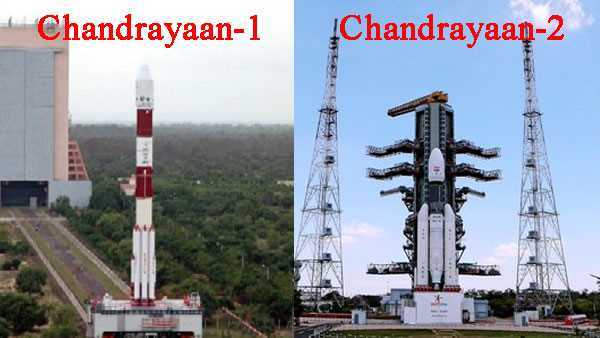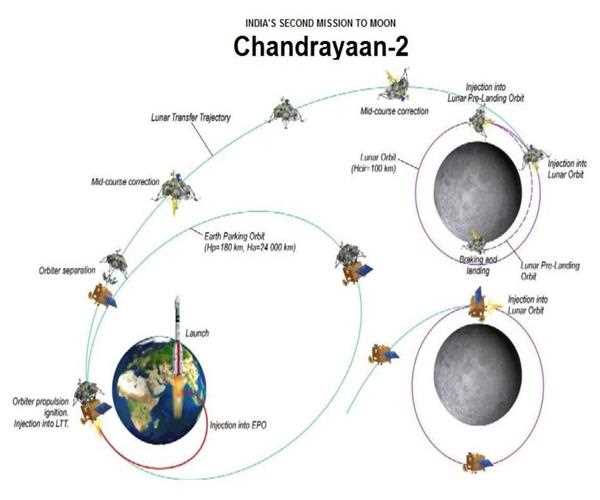Search here

30-Jul-2019 , Updated on 2/21/2020 1:48:51 AM
India’s Moon Mission
The Indian Space Research Organization (ISRO) has successfully launched India's second lunar mission at 2:43 P.M. on July 22, 2019. The launch of Chandrayaan-2 onboard GSLV MkIII-M1 has been taken from launch place Sriharikota, Andhra Pradesh. India's second-lunar mission is being launched 11 years after Chandrayaan-1, which was launched on October 22, 2008, from Satish Dhawan Space Centre at Sriharikota. Chandrayaan-2 is India's first space mission that will try to conduct a soft landing on the moon's Southern Pole Region. The mission will make India 4th country to the soft-land rover on the surface of the moon after Russia, America, and China.

According to ISRO, Chandrayaan-1 was operational for 312 days till August 29, 2009. In the meanwhile, it completed about 95% of the mission successfully. In which Chandrayaan-1 discovered traces of water on the moon, it has been a path-breaking discovery in the world of space science. Chandrayaan-1 also discovered water ice in the North Pole Region of the Moon and also detected Magnesium, Aluminum, and Silicon on the lunar surface. Global imaging of the moon is another achievement of this mission.
After a period of 11 years, Chandrayaan-2 has been launched successfully from Sriharikota. It is an updated version of Chandrayaan-1 which comprises of an orbiter, Lander (Vikram), and Rover (Pragyaan). Unlike Chandrayaan-1, this second moon mission will attempt to make the soft landing of Vikram on the surface and introduce a six-wheeled Rover (Pragyaan), which will carry out scientific experiments on the moon. However, the soft landing of Vikram lander is been expected to take place on September 6, 2019, on the moon’s surface.

The main objective of the Chandrayaan-1 is to study and provide new insights into understanding the Origin and Evolution of the Moon. Identify the presence of chemicals in lunar highland rocks, mapping the height variation of features of the lunar surface and chemical imaging of the permanently shadowed North and South Pole Regions. Whereas, the Objective of Chandrayyan-2 is to exhibit the ability to soft-land on the lunar surface and to operate a robotic rover on the moon’s surface. As far as, Scientific goals are considered, the objective is to study mineralogy, lunar topography, the lunar exosphere and signatures of hydroxyl, elemental abundance, and water ice.
The success of India has received appreciation worldwide including the public of Pakistan as well. Many said that India’s achievement offers its neighbors an opportunity to learn and innovate. However, many relate this achievement as a threat to them and their country and addressed its being in a dangerous neighborhood. Apart from this, the Embassies of different countries including Israel, the United States, and Germany conveyed their greetings to India's space agency for the "giant leap”.

In addition to all these appreciations, India has made many first-time milestones with the Chandrayaan-2 project. The project has been spearheaded by the two senior women scientists of ISRO. ISRO’s senior scientists ‘Ritu Karidhal’ and ‘Muthayya Vanitha’, both are popularly known as India’s ‘Rocket Women’ was leading the project. It includes the project oversight as well as the crucial final phase of Chandrayaan-2 landing. Ritu Karidhal is the Mission Director, while Muthayya Vanitha is the Project Director for Chandrayaan-2.
Apart from this, another highlight of Chandrayaan-2 is its engineering cost. The total cost of the Chandrayaan-2 is Rs. 978 crore or $142,651,080 ($142 Million) which includes the cost of mission Rs. 603 crore and the cost of its launch which is Rs. 375 crore. The expenses have been much less than the making of many Hollywood movies. With this achievement, ISRO has carved a niche for itself across the globe, in the sphere of Astronomy and Space Research for running cost-effective as well as less expensive projects.

Other
I am a content writter !
Join Our Newsletter
Subscribe to our newsletter to receive emails about new views posts, releases and updates.
Copyright 2010 - 2025 MindStick Software Pvt. Ltd. All Rights Reserved Privacy Policy | Terms & Conditions | Cookie Policy